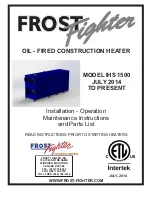
17
There must be:
•
A readily accessible manual shut off valve in the gas supply line
serving the water heater, and
•
A drip leg (sediment trap) ahead of the gas control valve to help
prevent dirt and foreign materials from entering the gas control
valve.
•
A flexible gas connector or a ground joint union between the shut
off valve and control valve to permit servicing of the unit.
Be sure to check all the gas piping for leaks before lighting the water
heater. Use a soapy water solution, not a match or open flame. Rinse
off soapy solution and wipe dry.
When installed at elevations above 5,000 feet (1524 m), input ratings
should be reduced at the rate of 4 percent for each 1,000 feet above
sea level.
Use pipe joint compound or teflon tape marked as being resistant to the
action of petroleum [Propane (L.P.)] gases.
The appliance and its gas connection must be leak tested before placing
the appliance in operation.
The appliance and its individual Shut-off valve shall be disconnected
from the gas supply piping system during any pressure testing of that
system at test pressures in excess of 1/2 pound per square inch
(3.5 kPa). It shall be isolated from the gas supply piping system by
closing its individual manual Shut-off valve during any pressure testing
of the gas supply piping system at test pressures equal to or less than
1/2 pound per square inch (3.5 kPa).
Connecting the gas piping to the gas control valve of the water heater
can be accomplished by either of the two methods shown in
Figures 28, 29 and 30.
SEDIMENT TRAPS
A sediment trap shall be installed as close to the inlet of the water
heater as practical at the time of water heater installation. The sediment
trap shall be either a tee fitting with a capped nipple in the bottom outlet
or other device recognized as an effective sediment trap. If a tee fitting
is used, it shall be installed in conformance with one of the methods of
installation shown in Figures 28,29 and 30.
FIGURE 28. GAS PIPING WITH FLEXIBLE CONNECTOR.
FIGURE 29. GAS PIPING WITH ALL
BLACK IRON PIPE TO GAS CONTROL.
ALTERNATIVE SEDIMENT TRAP LOCATION
FIGURE 30.
Contaminants in the gas lines may cause improper operation of the gas
control valve that may result in fire or explosion. Before attaching the
gas line be sure that all gas pipe is clean on the inside. To trap any dirt
or foreign material in the gas supply line, a drip leg (sometimes called a
sediment trap) must be incorporated in the piping. The drip leg must be
readily accessible. Install in accordance with the “Gas Piping” section.
Refer to the current edition of the National Fuel Gas Code, ANSI Z223.1/
NFPA 54.
FUEL CONVERSION INSTRUCTIONS
FROM NATURAL GAS TO PROPANE (L.P.) GAS
This water heater has been factory equipped to operate with the type
gas indicated in the “EQUIPPED FOR” area of the model rating plate
located near the gas control valve. The indicated gas may be either
Natural or Propane (L.P.). By following the conversion instructions in
this manual or the instructions near the gas control valve, the water
heater must be converted if it is to be used with the opposite gas. DO
NOT USE THIS WATER HEATER WITH ANY GAS OTHER THAN THE
ONE LISTED ON THE MODEL RATING PLATE. Failure to use the correct
gas can cause problems which can result in DEATH, SERIOUS BODILY












































